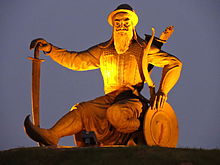Banda Singh Bahadur
| Banda Singh Bahadur ਬੰਦਾ ਸਿੰਘ ਬਹਾਦਰ |
|
|---|---|

Statue of Baba Banda Bahadur at Chappar Chiri
|
|
| Birth name | Lachman Dev |
| Born | 27 October 1670 Rajauri, Poonch, present-day Jammu and Kashmir[1] |
| Died | 9 June 1716 (aged 45) Delhi, Mughal Empire |
| Allegiance | |
| Children | 1 (Ajai Singh) |
| Religion | Sikhism |
| Teacher | Guru Gobind Singh |
| Part of a series on |
| Sikhism |
|---|
 |
His first major action was the sacking of the Mughal provincial capital, Samana, in November 1709.[1] After establishing his authority in Punjab, Banda Singh Bahadur abolished the zamindari system, and granted property rights to the tillers of the land. He was captured by the Mughals and tortured to death in 1715-1716.
Contents
Early life
There are different views regarding the origin of Banda Singh Bahadur:- The Encyclopaedia of Sikhism, published by the Punjabi University, Patiala, states that he was born at Rajauri in Jammu Kashmir, the son of Ram Dev, a ploughman of the Sodhi sub-caste of Khatris.[1]
- The Mahan Kosh, a Sikh encyclopaedia compiled by Bhai Kahan Singh Nabha (Bhasha Bibhag Punjab, Patiala), states that he was a Minhas Rajput, either from Rajouri in Jammu region or Doaba region of Punjab.[full citation needed]
- Giani Budh Singh, Poonch scholar, in his book Chhowen Rattan, described Banda Singh Bahadur as a Bairagi Brahmin.[citation needed]
- Harjinder Singh Dilgeer in his book Sikh Twareekh (1469–2007) (published by Singh Brothers Amritsar, in 5 volumes in 2008) narrates that Banda Singh was a Rajput, born in 1670. At the age of 16 he left his home and joined the party of wandering Hindu ascetics (sadhu). He spent two years with two Bairagi sadhus (Janki Das and then Ram Das)and hence got his last name Bairagi. He then joined Baba Lunia, near Burhanpur. In 1696, he met Guru Gobind Singh at Kankhal, near Haridwar but this was a short meeting. After this, Sri Guru Gobind Singh visited him in August 1708. Dilgeer's account is challenged by some Sikh authorities.[6][7]
Early conquests
After a meeting with Guru Gobind Singh on 3 September 1708, he became a Sikh.[1] The Guru ordered him to go to Khanda and fight the Mughals with the help of the Sikh army in Kaithal.[8]In 1709 he defeated Mughals in the Battle of Samana and captured the Mughal city of Samana, killing about 10,000 Mohammedans.[9][10]
Samana minted coins. With this treasury the Sikhs became financially stable. The Sikhs soon took over Mustafabad[1] and Sadhora (near Jagadhri).[11] The Sikhs then captured the Cis-Sutlej areas of Punjab, including Malerkotla and Nahan.[citation needed]
On 12 May 1710 in the Battle of Chappar Chiri the Sikhs killed Wazir Khan, the Governor of Sirhind and Dewan Suchanand, who were responsible for the martyrdom of the two youngest sons of Guru Gobind Singh. Two days later the Sikhs captured Sirhind. Banda Singh was now in control of territory from the Sutlej to the Yamuna and ordered that ownership of the land be given to the farmers, to let them live in dignity and self-respect.[12]
Sikh Raj
Banda Singh Bahadur developed the village of Mukhlisgarh, and made it his capital. He then renamed it to Lohgarh (fortress of steel) where he issued his own mint.[13] The coin described Lohgarh: "Struck in the City of Peace, illustrating the beauty of civic life, and the ornament of the blessed throne".[citation needed]He briefly established a state in Punjab for half a year. Banda Singh sent Sikhs to the Uttar Pradesh and Sikhs took over Saharanpur, Jalalabad, Muzaffarnagar and other nearby areas, bringing relief to the repressed population.[14] In the regions of Jalandhar and Amritsar, the Sikhs started fighting for the rights of the people. Banda Singh Bahadur captured Rahon after defeating Mughals in the Battle of Rahon (1710). Sikhs used their newly established power to remove corrupt officials and replace them with honest ones.[14]
Revolutionary
Banda Singh Bahadur is known to have halted the Zamindari system in the time he was active and gave the farmers proprietorship of their own land.[15] It seems that all classes of government officers were addicted to extortion and corruption and the whole system of regulatory and order was subverted.[16]Local tradition recalls that the people from the neighborhood of Sadaura came to Banda Singh complaining of the iniquities practices by their land lords. Banda Singh ordered Baj Singh to open fire on them. The people were astonished at the strange reply to their representation, and asked him what he meant. He told them that they deserved no better treatment when being thousands in number they still allowed themselves to be cowed down by a handful of Zamindars. He defeated the Sayyids and Shaikhs in the Battle of Sadhaura.[17]
Persecution from the Mughals
The rule of the Sikhs over the entire Punjab east of Lahore obstructed the communication between Delhi and Lahore, the capital of Punjab, and this worried Mughal Emperor Bahadur Shah He gave up his plan to subdue rebels in Rajasthan and marched towards Punjab.[18]The entire Imperial force was organized to defeat and kill Banda Singh Bahadur.[19] All the generals were directed to join the Emperor's army. To ensure that there were no Sikh agents in the army camps, an order was issued on 29 August 1710 to all Hindus to shave off their beards.[20]
Banda Singh was in Uttar Pradesh when the Moghal army under the orders of Munim Khan[21] marched to Sirhind and before the return of Banda Singh, they had already taken Sirhind and the areas around it. The Sikhs therefore moved to Lohgarh for their final battle. The Sikhs defeated the army but reinforcements were called and they laid siege on the fort with 60,000 troops.[22][23] Gulab Singh dressed himself in the garments of Banda Singh and seated himself in his place.[24]
Banda Singh left the fort at night and went to a secret place in the hills and Chamba forests. The failure of the army to kill or catch Banda Singh shocked Emperor, Bahadur Shah and On 10 December 1710 he ordered that wherever a Sikh was found, he should be murdered.[25] The Emperor became mentally disturbed and died on 18 February 1712.[26]
Banda Singh Bahadur wrote Hukamnamas to the Sikhs to reorganise and join him at once.[27] In 1712, the Sikhs gathered near Kiratpur Sahib and defeated Raja Ajmer Chand,[28] who was responsible for organizing all the Hill Rajas against Guru Gobind Singh and instigating battles with him. After Bhim Chand's dead the other Hill Rajas accepted their subordinate status and paid revenues to Banda Singh. While Bahadur Shah's four sons were killing themselves for the throne of the Mughal Emperor,[29] Banda Singh Bahadur recaptured Sadhaura and Lohgarh. Farrukh Siyar, the next Moghal Emperor, appointed Abdus Samad Khan as the governor of Lahore and Zakaria Khan, Abdus Samad Khan's son, the Faujdar of Jammu.[30]
In 1713 the Sikhs left Lohgarh and Sadhaura and went to the remote hills of Jammu and where they built Dera Baba Banda Singh.[31] During this time Sikhs were being persecuted especially by Mughals in the Gurdaspur region.[32] Banda Singh came out and captured Kalanaur and Batala[33] which rebuked Farrukh Siyar to issue Mughal and Hindu officials and chiefs to proceed with their troops to Lahore to reinforce his army.[34]
Siege in Gurdas Nangal
In March 1715, the army under the rule of Abdus Samad Khan,[35] the Mughal king of Delhi, drove Banda Bahadur and the Sikh forces into the village of Gurdas Nangal, Gurdaspur, Punjab and laid siege to the village.[36] The Sikhs defended the small fort for eight months under conditions of great hardship,[37] but on 7 December 1715 the Mughals broke into the starving garrison and captured Banda Singh and his companions.[1][38]Execution
Banda Singh Bahadur was put into an iron cage and the remaining Sikhs were chained.[39] The Sikhs were brought to Delhi in a procession with the 780 Sikh prisoners, 2,000 Sikh heads hung on spears, and 700 cartloads of heads of slaughtered Sikhs used to terrorise the population.[40][41] They were put in the Delhi fort and pressurised to give up their faith and become Muslims.[42]On their firm refusal all were ordered to be executed. Every day, 100 Sikhs were brought out of the fort and murdered in public.[43] This continued for approximately seven days.[44] After three months of confinement,[45] on 9 June 1716, Banda Singh's eyes were gouged out, his limbs were severed, his skin removed, and then he was killed.[1][46] His martydom created a spirit of courage among Sikhs. Soon all of Punjab would be up in arms to drive out Afghans and Mughals, culminating in Ranjit Singh becoming the Maharaja from Sindh to Kashmir.[citation needed]
Battles fought by Banda Singh
Prime Minister Narendra Modi and Punjab Chief Minister Parkash Singh Badal at the commemorative event to mark the 300th anniversary of the martyrdom of Baba Banda Singh Bahadur
- Battle of Sonepat
- Battle of Samana
- Battle of Chappar Chiri
- Battle of Sadhaura
- Battle of Lohgarh
- Battle of Jammu
- Battle of Rahon, (1710)
- Battle of Jalalabad (1710)
- Battle of Gurdas Nangal or Siege of Gurdaspur
- Battle of Sirhind
Baba Banda Singh Bahadur War Memorial
A war memorial was built where Battle of Chappar Chiri was fought, to glorify heroic Sikh soldiers.The 328 ft tall Fateh Burj was dedicated to Banda Singh Bahadur who led the army and defeated the Mughal Force. The Fateh Burj is taller than Qutab Minar and is an octagonal structure. There is a dome at the top of tower with Khanda made of stainless steel.
POSTED BY ; VIPUL KOUL.
SOURCES ; GIVEN

No comments:
Post a Comment